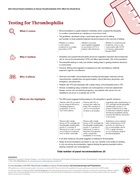ASH VTE Guidelines: Thrombophilia Testing
Thrombophilias include a variety of genetic mutations that are associated with increased risk of VTE. Thrombophilia, either acquired or hereditary, can be identified in many patients presenting with venous thromboembolism (VTE). The currently most commonly tested hereditary thrombophilias include deficiencies of antithrombin, protein C, or protein S, and the gain‐of‐function mutations Factor V Leiden (FVL) and prothrombin G20210A (PGM). Lupus anticoagulant, anticardiolipin antibodies, and anti‐ß2‐ glycoprotein1 antibodies, which are laboratory features of the acquired thrombophilic antiphospholipid syndrome (APS), are also generally included in a thrombophilia testing panel.
Thrombophilia testing can be performed in patients with VTE, particularly if they are young, have recurrent episodes, have thrombosis at unusual sites, or have a positive family history of the disease. The purpose of these guidelines is to provide evidence-based recommendations about whether thrombophilia testing and tailoring management based on the test result would improve patient‐important outcomes.
Access the full guidelines on the Blood Advances website:
Guideline Implementation Tools and Resources
ASH guidelines are reviewed annually by expert work groups convened by ASH. Resources derived from guidelines that require updating are removed from the ASH website.
VTE GUIDELINES: WHAT YOU SHOULD KNOW
This one-page snapshot provides a high-level summary of the guidelines for thrombophilia testing among patients with VTE or with a positive family history of VTE. A snapshot of the full VTE guidelines is also available for download.
ASH CLINICAL PRACTICE GUIDELINES APP
The ASH Clinical Practice Guidelines App provides easy access to every recommendation from all guidelines published by ASH, including rationale for each recommendation, benefits and harms associated with each recommended course of action, and links to the complete evidence-to-decision tables used to develop the recommendations. This app is also available via web interface.
Download for iOS Download for Android
Teaching Slides
Help your colleagues diagnose, manage, and treat VTE using teaching slides designed for easy dissemination.
- Teaching slides for Thrombophilia testing
Powerpoint | PDF
